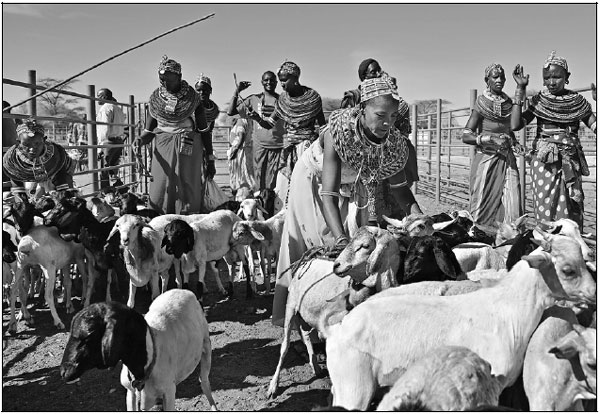Tradition meets tech as Kenyan herders adapt to climate change
MERILLE, Kenya - For generations, Kaltuma Hassan's clan would study the sky over Kenya's arid north for any sign of rain - some wind here, a wisp of cloud there - to guide their parched livestock to water.
But such divination has been rendered hopeless by intensifying droughts. Days on foot can reveal nothing more than bone-dry riverbeds and grazing land baked to dust, sounding the death knell for their herd.
"You might go a long distance, and they die on the way. ... It is a very hard life," Hassan said in Marsabit, a sparse and drought-prone expanse where millions of pastoral families depend entirely on livestock to survive.
|
Traditional Samburu tribeswomen gather their goats to be sold at Merille livestock market near Nairobi, Kenya, on April 30. Tony Karumba / Agence France-Presse |
Today, she leaves less to chance.
The 42-year-old relies on detailed rainfall forecasts received via text message from a Kenyan tech firm to plan her migrations, a simple but life-changing resource for an ancient community learning to adapt to increasing weather extremes.
Nomadic livestock herders in East Africa's drylands have endured climate variability for millennia, driving their relentless search for water and pasture in some of the world's most inhospitable terrain.
But their resilience is being severely tested by climate change, forcing a rethink to traditional wisdom passed down for generations.
Kenya endures a severe drought every three to five years, the World Bank says, but they are increasing in frequency and intensity, and temperatures are rising too.
With conditions evermore unreliable, Hassan no longer relies on warriors she once dispatched to scout for suitable grazing land for her cattle.
"They wake up very early in the morning and they look at the clouds, they look at the moon, to predict. I use this now," she said, scrolling through customized weather updates on her phone, sent via SMS in Rendille, a local language.
The service uses advanced weather data from US agricultural intelligence firm aWhere to provide subscribers with rain and forage conditions for the week ahead in their locality.
Text messages
The forecasts are sent as text messages, so they are compatible with basic phones often used by pastoralists in remote areas.
Kenyan IT firm Amfratech, which launched the SMS service earlier this year, has also rolled out a more advanced app-based version. They hope to eventually sign up tens of thousands of pastoralists.
Rainfall - the difference between feast and famine in East Africa and the Horn - is more erratic than ever, arriving late or not at all.
A long dry spell can set a pastoral family back years and erode their capacity to handle future shocks, the UN's Food and Agriculture Organization said in a 2018 report.
Such a crisis is already brewing in Kenya's pastoral country to the north and over its borders in neighboring arid regions.
This year's so-called long rains failed to arrive, putting millions at risk. The Famine Early Warning Systems Network has warned that hunger in pastoral areas will worsen in coming months.
Meanwhile, the text messages have helped Samuel Lkiangis Lekorima protect not just his livestock, but the safety of his community.
Longer, harsher droughts have stoked intense competition between pastoralists for ever-scarcer water and pasture. A feud between two groups over a watering hole near Ethiopia left 11 dead in May, local media reported.
Lekorima, a 22-year-old herder from Marsabit, said advance knowledge of rainfall helped keep his people wandering far, and avoid any potential tensions with distant clans.
"When I get that message, I phone people (and) tell them ... don't go far away, because there is rain soon," he said.
Other modern interventions are also playing a part, helping protect not just pastoralists but a sector that contributes more than 12 percent to Kenya's GDP, according to the World Bank.
The Nairobi-based International Livestock Research Institute uses satellite imagery to determine when pasture levels are critically low - a portent of livestock death.
Agence France-Presse
(China Daily 05/25/2019 page7)















